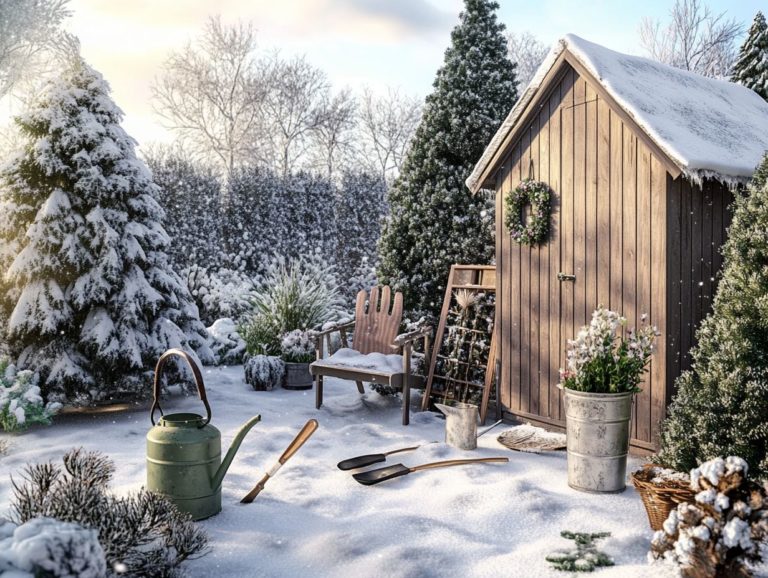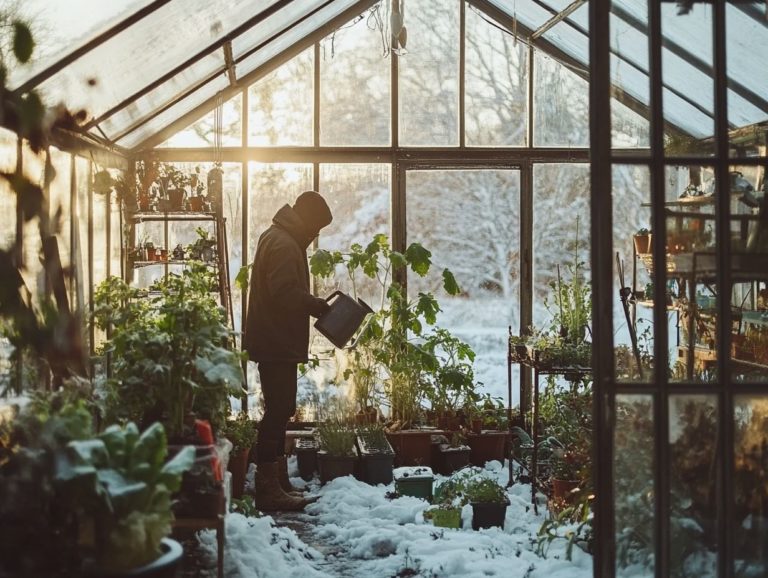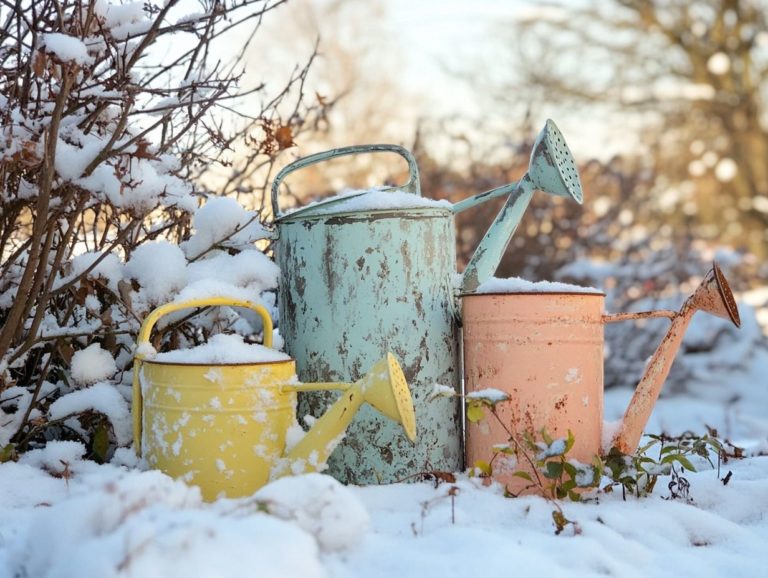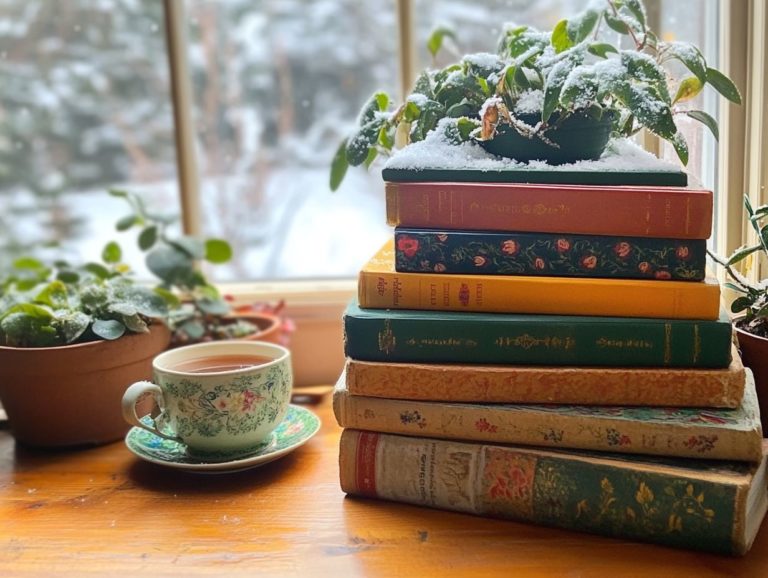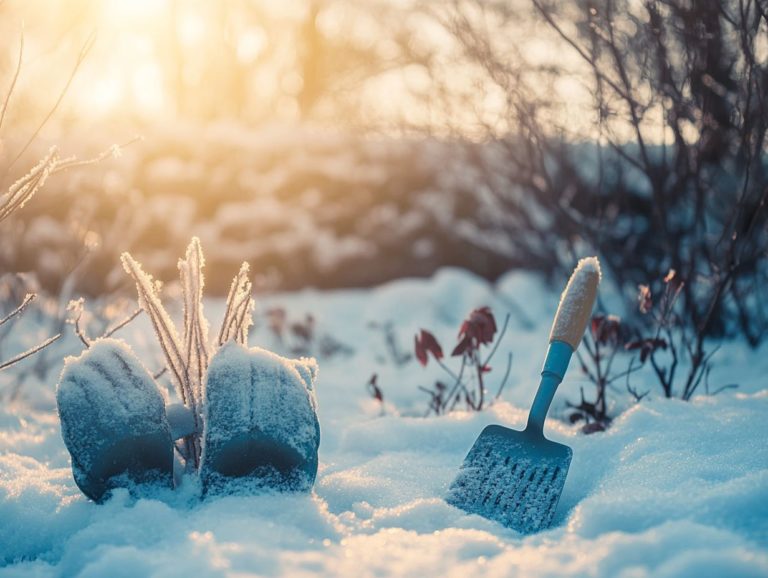Winter Gardening: 5 Tools to Help You Thrive
Winter gardening may appear intimidating at first glance, yet with the right tools and techniques, you can effortlessly transform your garden into a thriving oasis, even amidst the chill of winter.
Delve into essential tools such as cold frames, garden cloches, and heated seed mats, all meticulously crafted to extend your growing season and safeguard your sensitive plants against harsh weather conditions.
Uncover the myriad benefits of winter gardening, explore which plants flourish in colder climates, and arm yourself with strategies to tackle common challenges with finesse.
Get ready to embark on a thrilling winter garden adventure!
Contents
- Key Takeaways:
- 1. Cold Frames for Extended Growing Season
- 2. Garden Cloches for Protection Against Frost
- 3. Row Covers for Insulation and Pest Control
- 4. Heated Seed Mats for Germination
- 5. LED Grow Lights for Indoor Gardening
- How Can Winter Gardening Benefit Your Garden?
- Frequently Asked Questions
- What are the top 5 tools for winter gardening?
- Why is a sturdy shovel important for winter gardening?
- What makes a pair of sharp pruners essential for winter gardening?
- How does a rake help with winter gardening?
- Why should I use a hand trowel for winter gardening?
- Do I need gardening gloves for winter gardening?
Key Takeaways:
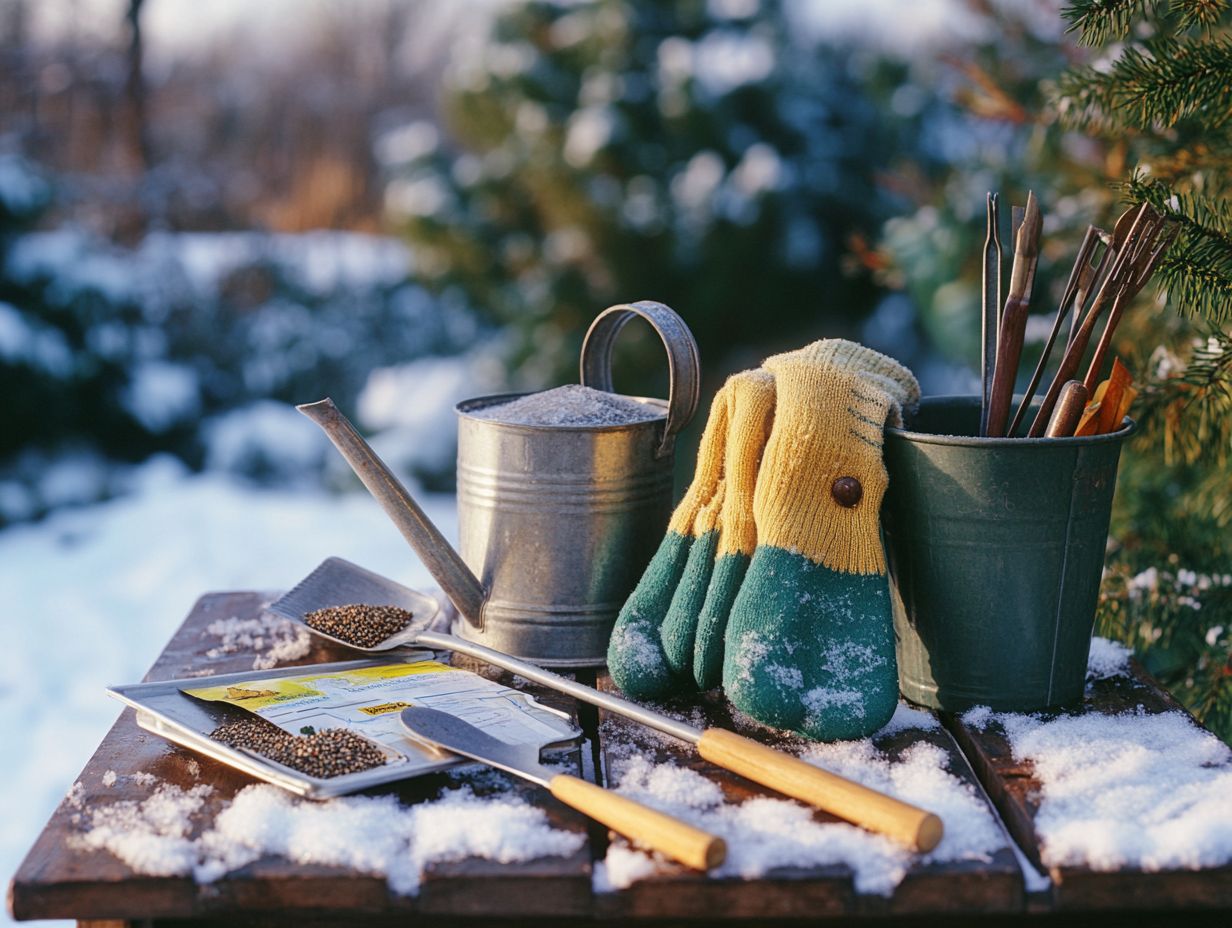
- Extend your growing season with cold frames. They create a warm environment for crops to thrive.
- Protect your sensitive plants from frost with garden cloches. They provide vital insulation.
- Keep pests and cold weather at bay with row covers. These versatile tools ensure healthy growth.
1. Cold Frames for Extended Growing Season
Cold frames are an invaluable asset for you as a gardener looking to extend your growing season. They allow you to cultivate a variety of crops, even in cooler climates like winter and late autumn.
By utilizing cold frames, you can create a small climate around your plants that protects your potted plants and seedlings from harsh weather, ensuring the soil remains warm for optimal health and growth.
These structures trap solar energy effectively, raising temperatures inside on sunny days ideal for those hardy greens and early spring vegetables. If you’re eager to maximize productivity, consider arranging your plants based on their sunlight and moisture needs; this technique can significantly enhance their growth.
With different types of cold frames available from wooden to PVC and glass you can choose one that offers the insulation you need. Positioning them next to your raised beds creates a seamless transition for your plants, allowing you to make the best use of space and resources while significantly boosting your yields throughout the year.
2. Garden Cloches for Protection Against Frost
Garden cloches are your go-to frost protection allies, expertly shielding your sensitive plants from biting cold temperatures and ensuring they stay healthy and vibrant during the chilly seasons.
These adaptable coverings come in a variety of materials glass, plastic, and even fabric each bringing its own set of advantages. Glass cloches are fantastic for insulation while still letting sunlight stream in, making them perfect for nurturing fragile seedlings.
On the other hand, plastic options are lightweight and easily maneuverable, although they might not provide the same warmth as glass. If you re tending to a garden in particularly harsh climates, consider mixing and matching different types to maximize crop production.
To use them effectively, remember to ventilate the cloches on sunny days to avoid overheating and to clean them regularly for optimal light transmission. By crafting a more stable small climate around your plants, garden cloches can significantly enhance their growth throughout the winter months.
3. Row Covers for Insulation and Pest Control
Row covers are your go-to gardening allies versatile tools that offer insulation and effective pest control, making them essential for nurturing your crops through the ups and downs of the seasons.
Made from materials like lightweight fabric, poly-spun, or breathable plastic, these covers do double duty by protecting your plants from harsh weather while keeping those pesky insects at bay. Using row covers can create a small climate around your plants that fosters healthier growth, allowing your seedlings to flourish even when the temperatures dip.
When you install them, it s essential to ensure they are properly anchored to resist the wind, all while leaving enough space for air circulation. Regularly checking the covers will help you manage moisture levels, preventing fungal diseases and ensuring your plants soak up sufficient sunlight.
By grasping and managing these factors, you can elevate your growing conditions and truly enhance the vitality of your plants.
With these tools and tips, your winter garden will thrive, so let’s get started!
4. Heated Seed Mats for Germination
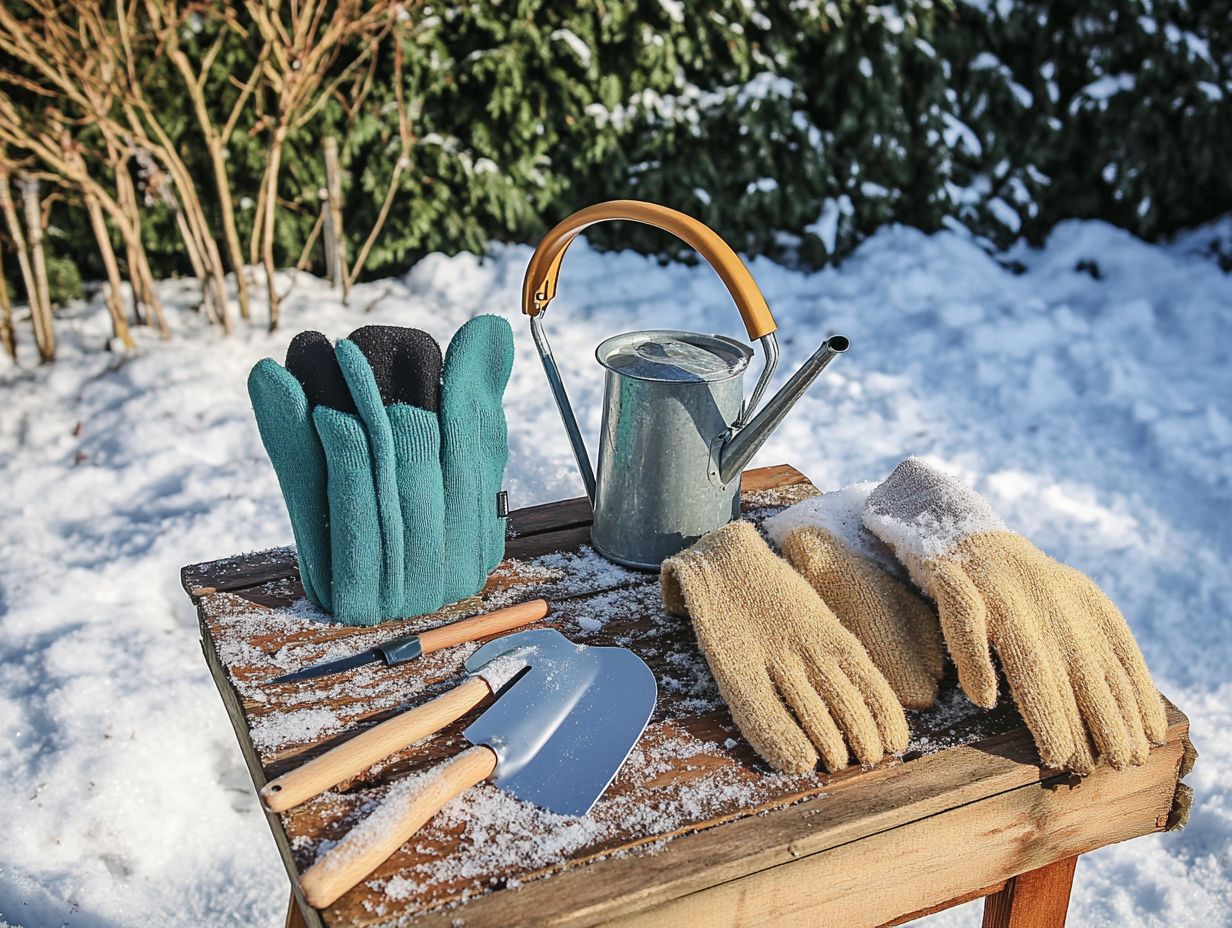
Heated seed mats are your secret weapon in gardening. They boost germination rates by providing consistent warmth to your seeds.
This warmth is essential for successful indoor planting and thriving crops. These mats create a stable environment that mimics perfect natural conditions, making them invaluable in cooler climates or during the off-season.
By generating warmth, they awaken dormant seeds, leading to quicker sprouting and healthier seedlings.
When you pair these mats with LED grow lights, you have a powerhouse setup for indoor gardening. The lights supplement the sunlight your plants crave, nurturing their growth even further.
To get the most from your seeds, keep temperatures between 70-85 F for popular vegetable seeds. Some might appreciate slightly cooler conditions. Look for mats with adjustable settings and use thermometers to ensure your seedlings thrive in their ideal environment.
Get your heated seed mat today and watch your seedlings thrive!
5. LED Grow Lights for Indoor Gardening
LED grow lights represent a remarkable advancement in indoor gardening, offering the vital light spectrum necessary for plant health and growth.
What sets these lights apart is their exceptional energy efficiency, using less electricity than traditional incandescent or fluorescent bulbs. This means noticeably lower energy bills for you.
Along with cutting energy costs, LED grow lights produce minimal heat, creating a stable environment for your delicate seedlings and reducing the risk of heat stress.
A wide variety of plants including herbs, leafy greens, and flowering species thrive under these lights, making them perfect for cultivating a diverse indoor garden.
For the best results, position the lights correctly, ideally 12 to 24 inches above your plants. This ensures even light distribution, adjusting the height as your plants grow.
Experience the difference with LED grow lights!
How Can Winter Gardening Benefit Your Garden?
Winter gardening presents a wealth of benefits for you as a gardener. It enables the cultivation of resilient crops and the possibility of enjoying a year-round harvest, even amidst frost and challenging climate conditions.
By embracing this practice, you can significantly enhance soil health by adding organic matter. This helps retain moisture and nutrients during the colder months.
Maintaining a winter garden encourages increased crop diversity, allowing you to explore the wonders of cold-hardy varieties.
Practical strategies include utilizing row covers and cold frames to protect your plants from harsh winds and freezing temperatures. Tools like frost blankets and cloches can further bolster your protection.
This thoughtful approach not only sustains plant life but also enriches your gardening experience throughout the winter.
What Types of Plants Can Be Grown in the Winter?
A remarkable variety of hardy plants can flourish in winter gardening, including leafy greens, root vegetables, and perennials.
Consider kale, Swiss chard, and carrots these resilient species not only endure frost but also often develop richer flavors during the chillier months.
As you plan your winter garden, pay attention to sunlight and soil requirements. Leafy greens prefer well-drained soil and at least 4-6 hours of direct sunlight each day.
Caring for these winter warriors involves keeping an eye on moisture levels and providing insulation think mulch to shield them from freezing temperatures.
If you’re looking to extend your growing season, consider utilizing greenhouses or cold frames. These setups can protect your plants from harsh weather, allowing you to cultivate an even more diverse range of crops.
Winter gardening can transform your gardening experience!
Facing Winter’s Challenges: How to Garden Smartly
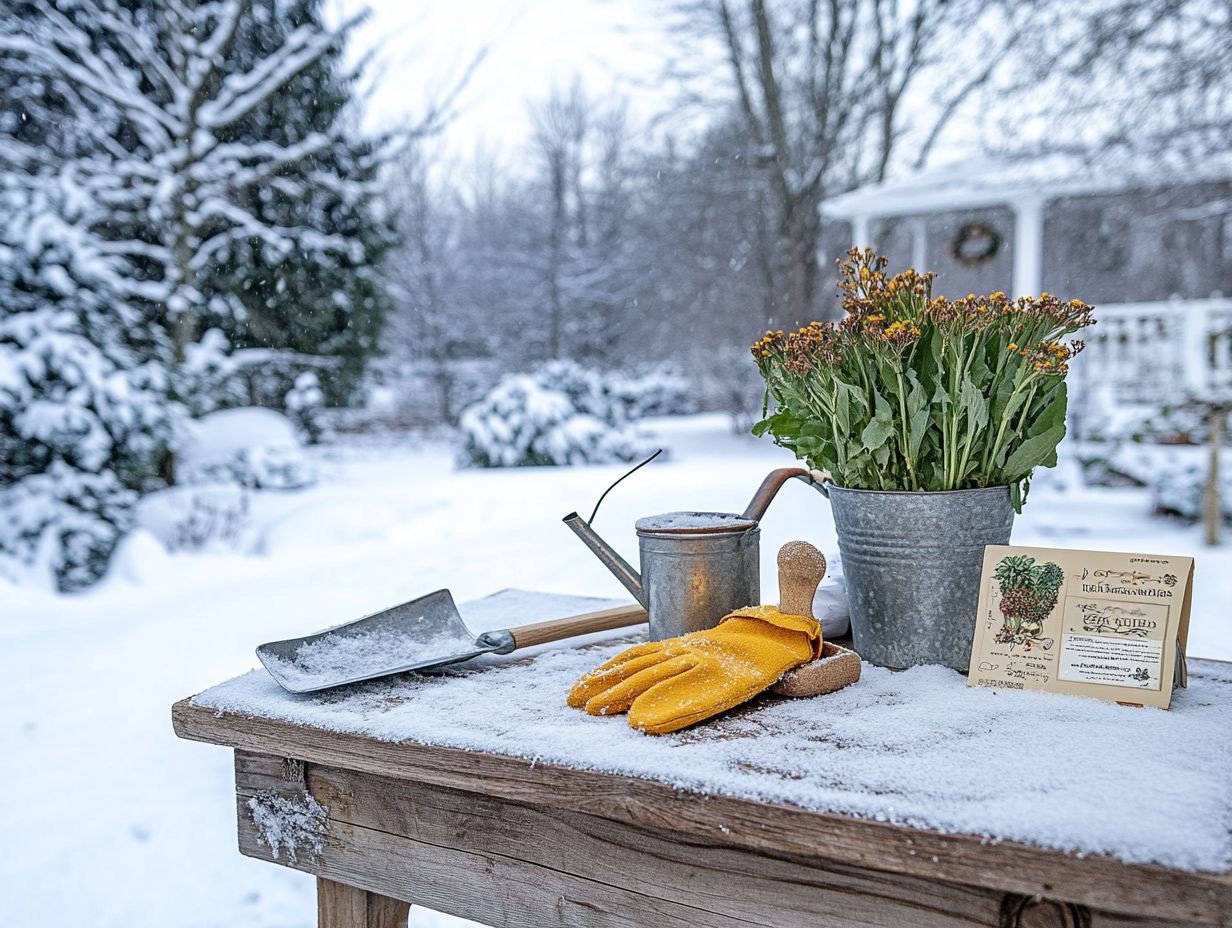
Winter gardening poses several challenges. You must protect your crops from frost and maintain healthy soil during tough weather.
Limited sunlight can hinder photosynthesis and growth rates on shorter days. Temperature swings can also be harsh; nighttime lows may damage delicate seedlings if they’re not sheltered properly.
To overcome these obstacles, consider using cold frames these are structures that help plants stay warm or row covers, which protect crops from the cold. Adding compost to your soil can enhance fertility and moisture retention. Tools like heat mats and grow lights will help your plants not just survive, but thrive this winter.
How Can Tools Help You Garden Better in Winter?
Using the right gardening tools can make winter gardening easier. They help you face seasonal challenges while keeping your plants healthy and boosting your harvest.
Row covers are fantastic for shielding tender plants from frost while still letting sunlight and moisture in. You can choose between lightweight and heavyweight covers, depending on your local climate.
Cloches, which are small protective covers for individual plants, create a mini-greenhouse effect that promotes growth. Heated mats help maintain optimal soil temperatures, especially for seedlings that love warmth.
When choosing your tools, consider the specific plants you re growing and how well they handle cold. This ensures that your methods suit their unique needs, leading to the best results.
Tips for Thriving in Winter Gardening
Successful winter gardening relies on practical tips that keep your plants healthy and your crops flourishing, even in winter’s chill.
To thrive in colder months, plan a planting schedule focusing on hardy vegetables like kale and carrots that can withstand frost. Implement frost protection methods, such as row covers and cloches, to safeguard your plants and extend their growing season.
Taking care of your soil is crucial. Layering organic mulch helps retain moisture and enriches the earth with nutrients. By using tools like cold frames and soil thermometers, you can optimize conditions for a more fruitful winter harvest.
Additional Tools for Winter Gardening Success
A variety of tools can enhance your winter gardening experience, offering advanced frost protection and effective soil management.
These tools boost plant resilience during colder months and streamline your gardening process. For example, temperature-regulating row covers trap warmth while letting light through, creating a warmer environment for your plants. Soil thermometers help you monitor ground temperatures, ensuring you plant at the right time.
Using these tools promotes healthy growth and reduces the risk of frost damage. Regularly check row covers for proper insulation and place thermometers strategically to gauge soil warmth effectively.
By incorporating these methods into your winter gardening routine, you can enjoy a more fruitful harvest, even in chilly conditions.
Frequently Asked Questions
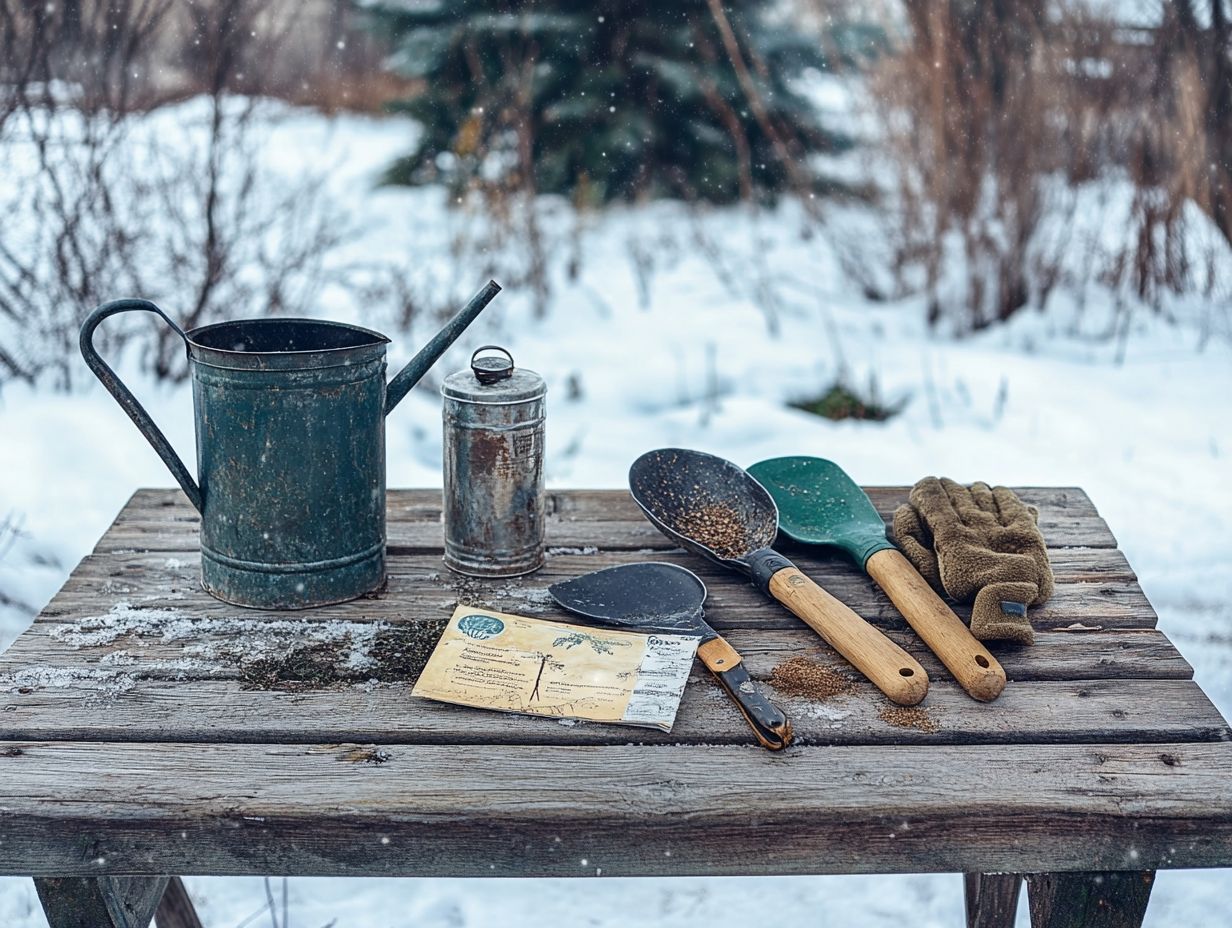
What are the top 5 tools for winter gardening?
The top 5 tools for winter gardening are a sturdy shovel, a pair of sharp pruners, a rake, a hand trowel, and a pair of gardening gloves.
Why is a sturdy shovel important for winter gardening?
A sturdy shovel is vital for winter gardening. It breaks through frozen ground and removes stubborn roots and weeds!
What makes a pair of sharp pruners essential for winter gardening?
Sharp pruners are a must-have during winter gardening. They cut through dead branches and help remove damaged or diseased plant parts easily!
How does a rake help with winter gardening?
A rake is a fantastic tool for winter gardening. It collects leaves, debris, and fallen fruits, keeping your garden tidy and healthy!
Why should I use a hand trowel for winter gardening?
A hand trowel is essential for your winter gardening toolkit. It helps transplant small plants, dig holes for bulbs, and remove weeds without hurting nearby plants!
Do I need gardening gloves for winter gardening?
Yes, gardening gloves are crucial in winter. They protect your hands from cold, wet soil and give you a better grip on your tools while you work!

